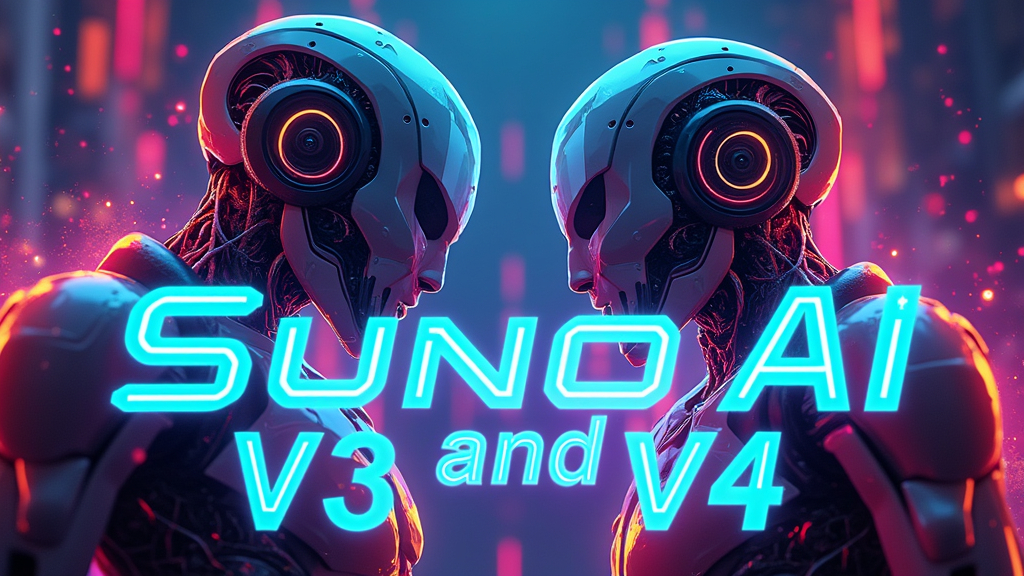Suno AI’s evolution from Version 3 to Version 4 marks a transformative leap in AI-powered music creation. While V3 laid the groundwork for accessible music generation, V4 refines and expands these capabilities with cutting-edge features. Here’s a breakdown of the key differences:
Core Improvements in Suno AI V4
1. Audio Quality and Vocal Realism
- V4: Boasts cleaner audio with reduced background noise and human-like vocals that are nearly indistinguishable from real singers. The vocal synthesis captures emotional nuances like vibrato and breath control.
- V3: Earlier versions had robotic vocals and occasional audio artifacts, especially in complex arrangements.
2. Lyric Generation
- V4: Introduces ReMi, an advanced lyric model that crafts sharper, genre-specific lyrics. Users report edgier outputs that better match musical themes.
- V3: Relied on simpler AI-generated lyrics, often generic or lacking creativity.
3. Song Length and Structure
- V4: Supports full-length tracks (up to 4+ minutes) with coherent endings and dynamic transitions.
- V3: Limited to shorter clips (2–3 minutes), with occasional abrupt endings.
New Features Exclusive to V4
| Feature | V4 Capabilities | V3/V3.5 Limitations |
|---|---|---|
| Remaster Tool | Enhances older tracks to V4’s audio standards | No remastering options |
| Personas | Save vocal/styles as reusable personas for consistent projects | Lacked style continuity tools |
| Covers | Reimagine uploaded audio with custom prompts (e.g., genre-swap) | Basic audio uploads without remixing |
| Real-Time Collaboration | Multiple users can edit tracks simultaneously | No collaboration features |
| DAW Integration | Direct export to Ableton Live, FL Studio, etc. | Limited third-party compatibility |
4. Genre Versatility and Prompt Responsiveness
- V4: Excels in pop, rock, and electronic genres but still struggles with niche styles like experimental or cinematic music. Prompt adherence is sharper, reducing “hallucinations.”
- V3: Less consistent in interpreting complex prompts, with a narrower genre range.
5. User Interface and Accessibility
- V4: Streamlined design with intuitive controls for both novices and pros. Features like instrumental mode and tempo adjustments are more accessible.
- V3: Functional but cluttered, requiring a steeper learning curve.
Performance and Practical Use
Instrument Quality
- V4: Guitars and high-pitched instruments still sound synthetic, though overall instrumentation is richer.
- V3: More noticeable artificial tones across all instruments.
Commercial Viability
- V4: Paid subscribers gain full commercial rights, making it viable for YouTubers and indie developers.
- V3: Limited by shorter tracks and weaker audio quality for professional use.
User Feedback: Praise and Criticisms
- Pros of V4:
- Lifelike vocals and radio-ready tracks.
- Remastering old projects breathes new life into them.
- Persona feature enables virtual artist development.
- Cons of V4:
- Overemphasis on pop music limits genre diversity.
- Harsh “R” pronunciations and occasional lyric missteps.
- No multi-vocalist support or advanced mixing tools.
The Bottom Line
Suno AI V4 isn’t just an upgrade—it’s a reimagining of AI music tools. While V3 democratized music creation, V4 refines it into a professional-grade platform. Musicians gain nuanced control over vocals and styles, while casual users enjoy polished results with minimal effort. However, instrument realism and genre flexibility remain areas for improvement. For those willing to experiment, V4’s $10/month Pro Plan offers unmatched value in AI music generation.
Explore Suno AI V4’s capabilities here: suno.com.



